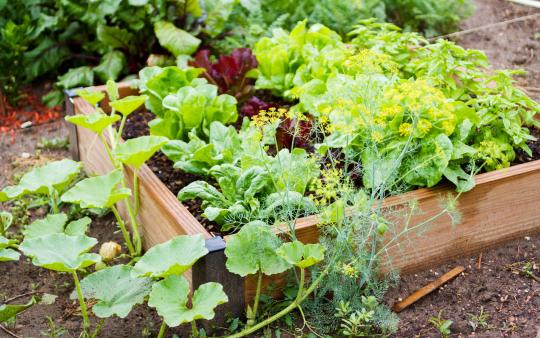Edible schoolyards aren’t just a way of teaching kids how to grow food, develop healthy eating habits, reduce obesity, and reduce the environmental impact of schools. They are also used to teach math, history, English, the sciences, and art. Through hands-on learning and relevant application of the subject matter at hand, children get excited about learning and retain knowledge better. Here's how to make one happen!
The consequences of a barren environment
The first school I went to was a small Catholic Francophone school in Kingston, Ontario. It was downtown and there was little space to work with, but our entire schoolyard consisted of asphalt. There was not a single tree or shrub on the lot. It certainly meant for lots of imaginative play since we had no climbing equipment either. We were left completely up to our own devices. Sadly, there are many schools that have sterile yards with little stimulation for children. A field of simple grass is not much better.
Experiments with rats show that the more complex the environment within a pup’s cage, the smarter they become. If they have nothing to interact with, i.e. a barren environment, they perform poorly on intelligence tests. Today, there are many outdoor classrooms being installed with native plants in my city of London, Ontario, but even more learning components could be added to them by incorporating edible schoolyards.
The history of edible schoolyards
The Edible Schoolyard movement started in Berkeley, California 40 years ago with Alice Waters, a local chef who cares deeply about sustainable food systems. The first school they tackled was Martin Luther King Jr. Middle School. They started by removing an acre of asphalt and converting it to garden space, and by the third year they had revived the abandoned cafeteria with a kitchen program. To integrate the larger community into what’s going on at the school garden they invite visitors, conduct tours, and welcome volunteers. They even have a flock of chickens and ducks in the garden whose eggs are used in the kitchen classroom.
Since 2010, permaculture designer Dustin Bajer has been inspiring schools in Canada to take on school gardens and food forests, and educating students about aquaponics systems. His first edible schoolyard project at Jasper Place High School in Edmonton, Alberta, had kids volunteering their spare periods to help him transform an empty school courtyard into a permaculture Eden. The space, the activities, and the food produced there were incorporated into several classes ranging from the culinary arts program, to Aboriginal studies and ecology.
Several of Toronto’s inner city communities are privileged to have Green Thumbs Growing Kids active in their neighbourhoods. This not-for-profit runs gardening programs for children in several Toronto schools and parks, reaching over 3000 children and their families, making for a very stimulating play environment!
What can your schoolyard become?
To get an edible schoolyard started in your neighbourhood requires a concerted effort. Collaboration between school administration, teachers, parents, and broader community is essential for it to be successful. In a northern climate, most food is produced over the summer holidays, not when children are in school, so community involvement is very important for summer maintenance. The use of perennial plants and guild systems, as employed when using permaculture design, will help reduce maintenance demands over the summer and ensure the garden is still thriving when children return to the classroom in September.
Structures that lengthen the growing season such as plastic hoop houses and cold frames, or ideally a greenhouse, are very helpful in extending the amount of time students can be involved in gardening. The former are easy to construct and low cost—students can even do the construction themselves—while the latter can be quite expensive and takes considerably more skill, likely requiring the involvement of a contractor.
An edible schoolyard can take many forms, from a simple vegetable patch, herb garden, or container garden, to a food forest with fruit trees integrated throughout and chickens running around doing pest control while providing protein-rich eggs for students. Be inspired by the big successful projects like Martin Luther King Jr. Middle School and others who have initiated big changes in their school environments, not intimidated. Start by getting together with some peers and discussing the possibilities. Dream. Plan. And make it happen.
The ABCs of starting an edible schoolyard
A. Create a rough outline and vision to help you explain what you are trying to do. Include:
- a list of potential benefits to the students, community and environment
- ideas for garden location
- a proposed timeline
- possible partners
- financial needs for start-up and long term care
- potential revenue generation from the garden or funding sources
- examples of similar projects in your city or nearby
- examples of curriculum tie-in (see further reading)
B. Present your idea to administration, or at a faculty, Home & School, or PTA meeting.
C. Form an advisory committee, once you have secured enough support to move forward, to continue implementation of the project. This should include representatives from all of the above groups as well as maintenance staff, food service staff (if present), students, and a community member or two.
*Originally published March 3, 2013
Further Reading
- How to Grow a School Garden: A Complete Guide for Parents and Teachers, by Arden Bucklin-Sporer
- Asphalt to Ecosystems: Design Ideas for Schoolyard Transformation, by Sharon Gamson Danks
- Smart by Nature: Schooling for Sustainability, by Michael K. Stone
- Edible Schoolyard: A Universal Idea, by Alice Waters






